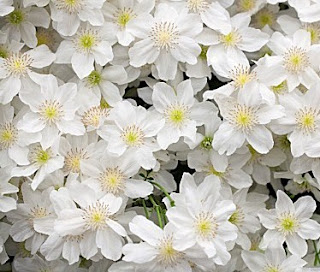Strolling around my favourite plant nurseries in quest for spring goodies, I came across one of the most professional and well conceived plant catalogues - the RHS online Plant Shop (www.rhsplants.co.uk)
Besides the accurate and useful plant facts, like growing conditions, dimensions and so on, they have grouped the plants by colours - and the effect is just stunning! You browse pages of cool blues, lavish purples, blazing reds and sizzling hot oranges and yes, an avalanche of cool, porcelain white blooms of any shape and type.
Sudden images of an impeccable white garden, with pure corollas embedded in dark green foliage crowd in my mind ...
I dream of an airy Wisteria floribunda Alba with long, undulating panicles, of clouds of pure clematis, and here comes a vision of the sheer delight of Clematis x cartmanii "Joe" and Avalanche, both delicate and clad in white stars. Beautiful beyond bearable levels! Not to say that unlike most Clematis ( which are all desirable of course) the leaves are ferny and decorative by themselves and hardy in mild zones... What could a gardener aspire at more??
Clematis x cartmanii Avalanche
Clematis x cartmanii Joe
The immaculate dense spires of Lupinus Noble Maiden
The opulence of the silky peony can hardly find a match in the garden, and here are two real oldies which prove to keep up with any new breed. Both can be found at relatively low prices, compared with more recent varieties, in many catalogues and make a feast in any garden. Festiva Maxima makes a perfect cut flower as well, long lasting and heavenly scented.
Peonia Lactiflora Krinkled White
Peonia Lactiflora Festiva Maxima
With its elegant heart shaped leaves, Brunnera macrophylla "Jack Frost" is entitled to stand next to all the other Belles in the Immaculate Garden.













